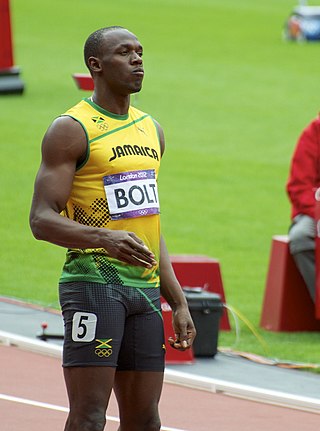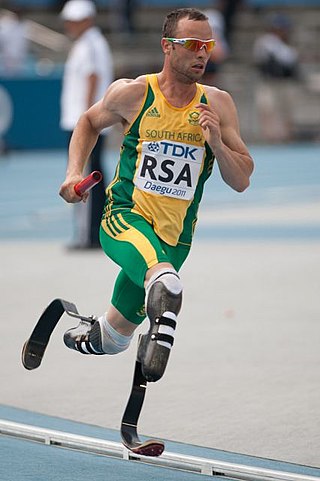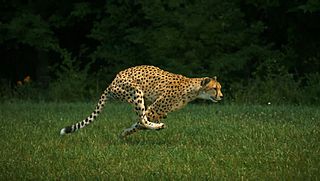Factors in speed
The key determinant of footspeed in sprinting is the predominance of one distinct type of muscle fibre over another, specifically the ratio of fast-twitch muscles to slow-twitch muscles in a sprinter's physical makeup. Though fast-twitch muscles produce no more energy than slow-twitch muscles when they contract, they do so more rapidly through a process of anaerobic metabolism, though at the cost of inferior efficiency over longer periods of firing. [1] The average human has an almost-equal ratio of fast-twitch to slow-twitch fibers, but top sprinters may have as much as 80% fast-twitch fibers, while top long-distance runners may have only 20%. [1] This ratio is believed to have genetic origins, though some assert that it can be adjusted by muscle training. [2] "Speed camps" and "Speed Training Manuals", which purport to provide fractional increases in maximum footspeed, are popular among budding professional athletes, and some sources estimate that 17–19% of speed can be trained. [2]
Though good running form is useful in increasing speed, fast and slow runners have been shown to move their legs at nearly the same rate – it is the force exerted by the leg on the ground that separates fast sprinters from slow. [3] Top short-distance runners exert as much as four times their body weight in pressure on the running surface. For this reason, muscle mass in the legs, relative to total body weight, is a key factor in maximizing footspeed. [3]

Running is a method of terrestrial locomotion by which humans and other animals move rapidly on foot. Running is a gait with an aerial phase in which all feet are above the ground. This is in contrast to walking, where one foot is always in contact with the ground, the legs are kept mostly straight, and the center of gravity vaults over the stance leg or legs in an inverted pendulum fashion. A feature of a running body from the viewpoint of spring-mass mechanics is that changes in kinetic and potential energy within a stride co-occur, with energy storage accomplished by springy tendons and passive muscle elasticity. The term "running" can refer to a variety of speeds ranging from jogging to sprinting.

Human-powered transport is the transport of person(s) and/or goods (freight) using human muscle power. Unlike animal-powered transport, human-powered transport has existed since time immemorial in the form of walking, running and swimming, as well as small vehicles such as litters, rickshaws, wheelchairs and wheelbarrows. Modern technology has allowed mechanical advantage devices and machines to enhance human-power.

Sprinting is running over a short distance at the top-most speed of the body in a limited period of time. It is used in many sports that incorporate running, typically as a way of quickly reaching a target or goal, or avoiding or catching an opponent. Human physiology dictates that a runner's near-top speed cannot be maintained for more than 30–35 seconds due to the depletion of phosphocreatine stores in muscles, and perhaps secondarily to excessive metabolic acidosis as a result of anaerobic glycolysis.

Skeletal muscles are organs of the vertebrate muscular system and typically are attached by tendons to bones of a skeleton. The muscle cells of skeletal muscles are much longer than in the other types of muscle tissue, and are often known as muscle fibers. The muscle tissue of a skeletal muscle is striated – having a striped appearance due to the arrangement of the sarcomeres.
In biology, a motor unit is made up of a motor neuron and all of the skeletal muscle fibers innervated by the neuron's axon terminals, including the neuromuscular junctions between the neuron and the fibres. Groups of motor units often work together as a motor pool to coordinate the contractions of a single muscle. The concept was proposed by Charles Scott Sherrington.

Physical strength is the measure of an individual's exertion of force on physical objects. Increasing physical strength is the goal of strength training.

Justin Alexander Gatlin is a retired American sprinter who competed in the 60 meters, 100 meters, and 200 meters. He is the 2004 Olympic Champion in the 100 meters, the 2005 and 2017 World Champion in the 100 meters, the 2005 World Champion in the 200 meters, and the 2019 World Champion in the 4 x 100 meters relay. In addition, Gatlin is the 2003 and 2012 World Indoor Champion in the 60 meters. He is a 5-time Olympic medalist and a 12-time World Championship medalist. At the World Athletics Relays, Gatlin won two gold medals in the 4 x 100 meters relay in 2015 and 2017. Gatlin is also a record 3-time Diamond League Champion in the 100 meters. He won the Diamond League trophy in 2013, 2014 and 2015.

The 100 metres, or 100-meter dash, is a sprint race in track and field competitions. The shortest common outdoor running distance, the 100-meter (109.36 yd) dash is one of the most popular and prestigious events in the sport of athletics. It has been contested at the Summer Olympics since 1896 for men and since 1928 for women. The inaugural World Championships were in 1983.

60 metres, or 60-meter dash, is a sprint event in track and field. It is a championship event for indoor championships, normally dominated by the best outdoor 100 metres runners. At indoor events, the 60 metres is run on lanes set out in the middle of the 'field', as is the hurdles event over the same distance, thus avoiding some of the effects of the banked track encircling the venue, upon which other track events in indoor events are run. At outdoor venues it is a rare distance, at least for senior athletes. The format of the event is similar to other sprint distances. The sprinters follow three initial instructions: 'on your marks', instructing them to take up position in the starting blocks; 'set', instructing them to adopt a more efficient starting posture, which also isometrically preloads their muscles. This will enable them to start faster. The final instruction is the firing of the starter's pistol. Upon hearing this the sprinters stride forwards from the blocks.

Wallace Spearmon Jr. is a retired American sprint athlete, who specializes in the 200 meters. He is a two-time NCAA outdoor champion in the 200 m and won the silver medal in the event at the 2005 World Championships in Athletics. He has a personal best of 19.65 seconds for the distance, making him the thirteenth fastest 200 meter runner of all time, and he formerly held the indoor American record.
Complex training, also known as contrast training or post-activation potentiation training, involves the integration of strength training and plyometrics in a training system designed to improve explosive power. According to Jace Derwin:
Strength training and plyometric training are both effective measures for increasing athletic performance independent of each other, but a true program designed for power-based athletes needs to incorporate both disciplines. A study done in 2000 in the NSCA's Journal of Strength and Conditioning Research measured three different training protocols: strength training, plyometric training, and a combination of both. The group that used combined methods was the only group that showed significant increases in BOTH strength and power.

Usain St. Leo Bolt is a Jamaican retired sprinter, widely considered to be the greatest sprinter of all time. He is the world record holder in the 100 metres, 200 metres, and 4 × 100 metres relay.

The men's 100 metres sprint event at the 2008 Olympic Games took place on 15 and 16 August at the Beijing National Stadium. Eighty athletes from 64 nations competed. Each nation was limited to 3 athletes per rules in force since the 1930 Olympic Congress. The final was won by Jamaican Usain Bolt in a world record time of 9.69 seconds. It was Jamaica's first title in the event, and first medal in the event since 1976. Jamaica became the first country to join the men's 100 metre winners since Trinidad and Tobago, also in 1976; Richard Thompson won that country's fourth overall medal in the event with his silver.

Alpha-actinin-3, also known as alpha-actinin skeletal muscle isoform 3 or F-actin cross-linking protein, is a protein that in humans is encoded by the ACTN3 gene located on chromosome 11. All people have two copies (alleles) of this gene.
The preferred walking speed is the speed at which humans or animals choose to walk. Many people tend to walk at about 1.42 metres per second. Individuals find slower or faster speeds uncomfortable.
This is a list of the fastest animals in the world, by types of animal.

Limitations of animal running speed provides an overview of how various factors determine the maximum running speed. Some terrestrial animals are built for achieving extremely high speeds, such as the cheetah, pronghorn, race horse and greyhound, while humans can train to achieve high sprint speeds. There is no single determinant of maximum running speed: however, certain factors stand out against others and have been investigated in both animals and humans. These factors include: Muscle moment arms, foot morphology, muscle architecture, and muscle fiber type. Each factor contributes to the ground reaction force (GRF) and foot contact time of which the changes to increase maximal speed are not well understood across all species.

The mechanics of the running blades used by South African former Paralympic runner Oscar Pistorius depend on special carbon-fiber-reinforced polymer prosthetics. Pistorius has double below-the-knee amputations and competed in both non-disabled and T44 amputee athletics events. Pistorius's eligibility to run in international non-disabled events is sanctioned by the International Association of Athletics Federations (IAAF).

The men's 100 metres event at the 2016 Summer Olympics took place between 13–14 August at the Olympic Stadium. 84 athletes from 57 nations competed.

Sarah, also known as Sahara, was a female South African cheetah that lived in the Cincinnati Zoo in Cincinnati, Ohio. Sarah was known as the world's fastest land mammal according to National Geographic magazine. She ran 100 meters in 5.95 seconds in 2012, when she was 11 years old. She died on January 22, 2016, at the supposed age of 15.
















